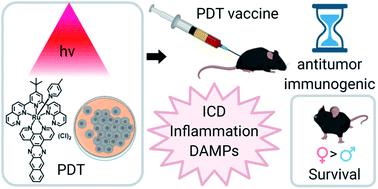当前位置:
X-MOL 学术
›
Chem. Sci.
›
论文详情
Our official English website, www.x-mol.net, welcomes your
feedback! (Note: you will need to create a separate account there.)
Near-infrared absorbing Ru(II) complexes act as immunoprotective photodynamic therapy (PDT) agents against aggressive melanoma
Chemical Science ( IF 7.6 ) Pub Date : 2020-09-09 , DOI: 10.1039/d0sc03875j Liubov M Lifshits 1 , John A Roque Iii 1, 2 , Prathyusha Konda 3 , Susan Monro 4 , Houston D Cole 1 , David von Dohlen 2 , Susy Kim 5 , Gagan Deep 5 , Randolph P Thummel 6 , Colin G Cameron 1 , Shashi Gujar 3, 7, 8, 9 , Sherri A McFarland 1
Chemical Science ( IF 7.6 ) Pub Date : 2020-09-09 , DOI: 10.1039/d0sc03875j Liubov M Lifshits 1 , John A Roque Iii 1, 2 , Prathyusha Konda 3 , Susan Monro 4 , Houston D Cole 1 , David von Dohlen 2 , Susy Kim 5 , Gagan Deep 5 , Randolph P Thummel 6 , Colin G Cameron 1 , Shashi Gujar 3, 7, 8, 9 , Sherri A McFarland 1
Affiliation

|
Mounting evidence over the past 20 years suggests that photodynamic therapy (PDT), an anticancer modality known mostly as a local treatment, has the capacity to invoke a systemic antitumor immune response, leading to protection against tumor recurrence. For aggressive cancers such as melanoma, where chemotherapy and radiotherapy are ineffective, immunomodulating PDT as an adjuvant to surgery is of interest. Towards the development of specialized photosensitizers (PSs) for treating pigmented melanomas, nine new near-infrared (NIR) absorbing PSs based on a Ru(II) tris-heteroleptic scaffold [Ru(NNN)(NN)(L)]Cln, were explored. Compounds 2, 6, and 9 exhibited high potency toward melanoma cells, with visible EC50 values as low as 0.292–0.602 μM and PIs as high as 156–360. Single-micromolar phototoxicity was obtained with NIR-light (733 nm) with PIs up to 71. The common feature of these lead NIR PSs was an accessible low-energy triplet intraligand (3IL) excited state for high singlet oxygen (1O2) quantum yields (69–93%), which was only possible when the photosensitizing 3IL states were lower in energy than the lowest triplet metal-to-ligand charge transfer (3MLCT) excited states that typically govern Ru(II) polypyridyl photophysics. PDT treatment with 2 elicited a pro-inflammatory response alongside immunogenic cell death in mouse B16F10 melanoma cells and proved safe for in vivo administration (maximum tolerated dose = 50 mg kg−1). Female and male mice vaccinated with B16F10 cells that were PDT-treated with 2 and challenged with live B16F10 cells exhibited 80 and 55% protection from tumor growth, respectively, leading to significantly improved survival and excellent hazard ratios of ≤0.2.
中文翻译:

近红外吸收钌 (II) 复合物作为免疫保护光动力疗法 (PDT) 药剂对抗侵袭性黑色素瘤
过去 20 年来越来越多的证据表明,光动力疗法 (PDT) 是一种主要被称为局部治疗的抗癌方式,它能够引发全身性抗肿瘤免疫反应,从而防止肿瘤复发。对于黑色素瘤等侵袭性癌症,化疗和放疗无效,免疫调节 PDT 作为手术的辅助手段是令人感兴趣的。为了开发用于治疗色素性黑色素瘤的专用光敏剂 (PSs),九种基于 Ru( II ) 三异配支架 [Ru(NNN)(NN)(L)]Cl n的新型近红外 (NIR) 吸收 PSs ,进行了探索。化合物2、6和9对黑色素瘤细胞表现出高效力,具有可见的 EC50 个值低至 0.292–0.602 μM,PI 高达 156–360。使用近红外光 (733 nm) 获得单微摩尔光毒性,PI 高达 71。这些先导近红外 PS 的共同特征是高单线态氧( 1 O 2 ) 量子产率 (69–93%),只有当光敏3 IL 态的能量低于通常控制 Ru( II ) 多吡啶基光物理学的最低三重态金属到配体电荷转移 ( 3 MLCT) 激发态. PDT 治疗2在小鼠 B16F10 黑色素瘤细胞中引起促炎反应以及免疫原性细胞死亡,并证明对体内给药是安全的(最大耐受剂量 = 50 mg kg -1)。接种 B16F10 细胞的雌性和雄性小鼠用2进行 PDT 处理并用活 B16F10 细胞攻击分别表现出 80% 和 55% 的肿瘤生长保护,从而显着提高存活率和 ≤0.2 的出色风险比。
更新日期:2020-10-11
中文翻译:

近红外吸收钌 (II) 复合物作为免疫保护光动力疗法 (PDT) 药剂对抗侵袭性黑色素瘤
过去 20 年来越来越多的证据表明,光动力疗法 (PDT) 是一种主要被称为局部治疗的抗癌方式,它能够引发全身性抗肿瘤免疫反应,从而防止肿瘤复发。对于黑色素瘤等侵袭性癌症,化疗和放疗无效,免疫调节 PDT 作为手术的辅助手段是令人感兴趣的。为了开发用于治疗色素性黑色素瘤的专用光敏剂 (PSs),九种基于 Ru( II ) 三异配支架 [Ru(NNN)(NN)(L)]Cl n的新型近红外 (NIR) 吸收 PSs ,进行了探索。化合物2、6和9对黑色素瘤细胞表现出高效力,具有可见的 EC50 个值低至 0.292–0.602 μM,PI 高达 156–360。使用近红外光 (733 nm) 获得单微摩尔光毒性,PI 高达 71。这些先导近红外 PS 的共同特征是高单线态氧( 1 O 2 ) 量子产率 (69–93%),只有当光敏3 IL 态的能量低于通常控制 Ru( II ) 多吡啶基光物理学的最低三重态金属到配体电荷转移 ( 3 MLCT) 激发态. PDT 治疗2在小鼠 B16F10 黑色素瘤细胞中引起促炎反应以及免疫原性细胞死亡,并证明对体内给药是安全的(最大耐受剂量 = 50 mg kg -1)。接种 B16F10 细胞的雌性和雄性小鼠用2进行 PDT 处理并用活 B16F10 细胞攻击分别表现出 80% 和 55% 的肿瘤生长保护,从而显着提高存活率和 ≤0.2 的出色风险比。











































 京公网安备 11010802027423号
京公网安备 11010802027423号